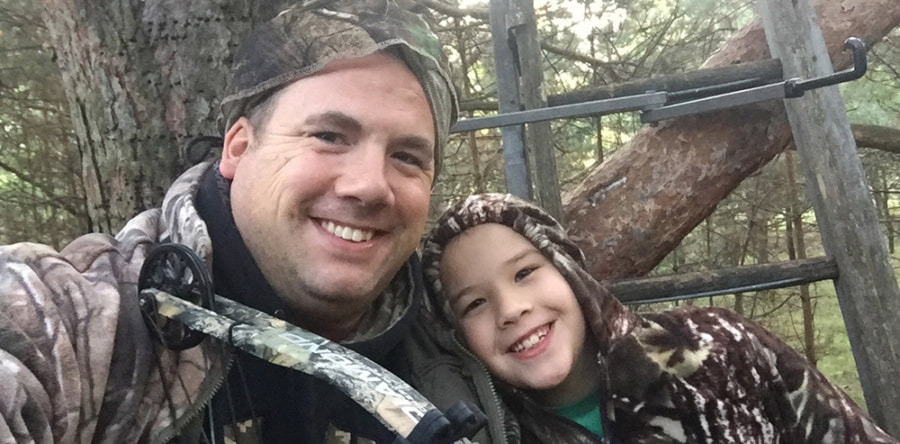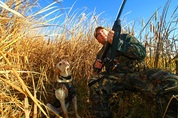
The very nature of white-tailed deer archery hunting involves a great deal of silence with the goal of luring in a creature with arguably the best hearing in the woods. A good friend and I were chatting about that just the other day, exchanging stories of miniscule noises escaping our bows and busting us during the long but quick-moving Minnesota whitetail archery season.
I spend about half of my archery hunt in a blind and the other half in a treestand. Actually, I spend another half walking around, spot-and-stalk hunting, but my math skills are only slightly better than my stalking skills, so that’s hardly worth mentioning.
While I reserve those hunting hours for when I believe there’s the best chance of being successful for myself, I like to bring one of my kids along for hunts, too.
Two of my hunting locations are within walking distance of either my house or my parents' house and I take advantage of those opportunities to get my kids in the woods for some of the greatest life lessons around.
This will probably be the last year I’ll do that without having one of them hunting alongside me because my 10-year-old son is getting his bow close to legal hunting draw weight. He’s convinced that he’ll make his first hunt later this season, but we’ll see. A few weeks ago I told him that I want to see his groupings get tighter, and since I’ve said that, he’s vastly improved. The kid is motivated.
I’m convinced that his desire and drive is the result of bringing him into the woods with me frequently, even when I knew his presence probably doesn’t help my success.
Sitting together in a double deer stand is challenging simply because it’s tough to mask noise and movement. It’s also tricky because it requires managing two harnesses in tight quarters. We spend almost all of our time together in a ground blind or stump-sitting.
The age and ability of your child to sit still for any length of time is the greatest barometer of how long you can hunt with a little buddy. When we first started, at the request of the kids, I told them they have to sit for at least 20 minutes to return. This served as a good beginning benchmark, and now we usually measure our times in hours.
Snacks help and I feel terrible admitting it, but a digital device with silent activities can help break up the monotony (for kids of all ages). Just remember that the point of being out there is to watch the woods and sit in silence. Avoid headphones and limit usage to just a few sporadic minutes.
A love of hunting and the outdoors is something that’s cultivated over time and evolves from short sessions to longer outings. It’s a busy world, so finding time to hunt is tough enough without trying to mentor young people as well, but the investment is well worth it.
Not only am I gaining future hunting partners, I’m also helping keep this rich tradition alive for all of us. Hunting requires hunters so we have to home-grow the sport if we want to keep it around.
One hunter at a time.
For more information on the youth recruitment efforts at Outdoor News, visit the Junior Pro Team website.
I spend about half of my archery hunt in a blind and the other half in a treestand. Actually, I spend another half walking around, spot-and-stalk hunting, but my math skills are only slightly better than my stalking skills, so that’s hardly worth mentioning.
While I reserve those hunting hours for when I believe there’s the best chance of being successful for myself, I like to bring one of my kids along for hunts, too.
Two of my hunting locations are within walking distance of either my house or my parents' house and I take advantage of those opportunities to get my kids in the woods for some of the greatest life lessons around.
This will probably be the last year I’ll do that without having one of them hunting alongside me because my 10-year-old son is getting his bow close to legal hunting draw weight. He’s convinced that he’ll make his first hunt later this season, but we’ll see. A few weeks ago I told him that I want to see his groupings get tighter, and since I’ve said that, he’s vastly improved. The kid is motivated.
I’m convinced that his desire and drive is the result of bringing him into the woods with me frequently, even when I knew his presence probably doesn’t help my success.
Sitting together in a double deer stand is challenging simply because it’s tough to mask noise and movement. It’s also tricky because it requires managing two harnesses in tight quarters. We spend almost all of our time together in a ground blind or stump-sitting.
The age and ability of your child to sit still for any length of time is the greatest barometer of how long you can hunt with a little buddy. When we first started, at the request of the kids, I told them they have to sit for at least 20 minutes to return. This served as a good beginning benchmark, and now we usually measure our times in hours.
Snacks help and I feel terrible admitting it, but a digital device with silent activities can help break up the monotony (for kids of all ages). Just remember that the point of being out there is to watch the woods and sit in silence. Avoid headphones and limit usage to just a few sporadic minutes.
A love of hunting and the outdoors is something that’s cultivated over time and evolves from short sessions to longer outings. It’s a busy world, so finding time to hunt is tough enough without trying to mentor young people as well, but the investment is well worth it.
Not only am I gaining future hunting partners, I’m also helping keep this rich tradition alive for all of us. Hunting requires hunters so we have to home-grow the sport if we want to keep it around.
One hunter at a time.
For more information on the youth recruitment efforts at Outdoor News, visit the Junior Pro Team website.

 RSS Feed
RSS Feed
